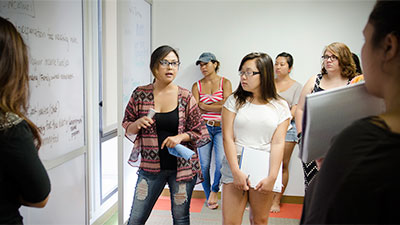There is a new innovation zone in Sakamaki Hall on the University of Hawaiʻi at Mānoa campus that includes three new classroom spaces—and these are not your mom and dad’s college classrooms.

They feature easy-to-move, comfortable, flexible furniture that allows for multiple seating and standing options; walls and walls of white boards and sliding plexiglass surfaces to write on; the latest technologies for content display and sharing; bright rooms filled with natural light, ample outlets and a lot of space to move around.
“It’s really a different kind of space in which you are invited to participate, you’re invited to be active and the old classroom has really been turned inside out,” said Reed Dasenbrock, the vice chancellor of academic affairs at UH Mānoa.
Thanks to the faculty driven designs, the active teacher, passive student model—a professor lecturing to students seated in rows of fixed seats—is gone.
“The design of this classroom, which is so different, is intended to model what learning really is like,” added Dasenbrock. “Learning does not take place by sitting and listening to the professor but by the professor designing an environment in which students have to do things.”
Rod Labrador, an ethnic studies professor at UH Mānoa, agrees. “It forces me to be a little more creative in what I am doing,” explains Labrador. “It forces me to come up with activities that utilize the space. It really forces me to—to be all clichéd—think outside of the box.”
The classrooms are designed to easily incorporate group work and collaboration that can be quickly shared and discussed with the entire class.
“Working together and using it in class would lead to more of their own grasping and ownership of the material,” said Kaliko Baker, a UH Mānoa Hawaiian language instructor.
Students say the new environment fosters better learning.
“Personally, I feel like I learn more from discussion and other students’ perspectives,” said student Ānuenue Purcell.
“I learn better talking through things, which this space gives that opportunity,” added fellow student Ruben Campos.
That’s why the new classroom spaces were designed with comfort and agility in mind: to be more like a living room or café instead of a classroom from the 1960s.
Related UH News video: New classroom and teaching
technique tested at UH Mānoa, September 24, 2012
“The chairs, you can actually sit on the back of the chair,” said Campos.
“Everyone is a little bit more comfortable and relaxed,” said Purcell.
“The circular chairs are nice for getting different people to actually speak up in class,” said Campos.
“They’re sitting on the ground, others are standing up,” said Labrador. “It allows them a certain amount of freedom.”
It’s all part of UH Mānoa’s movement towards agility in education to create more engaged opportunities to teach and learn. It also advances the larger UH System initiative to develop 21st century facilities across the 10 campuses.

